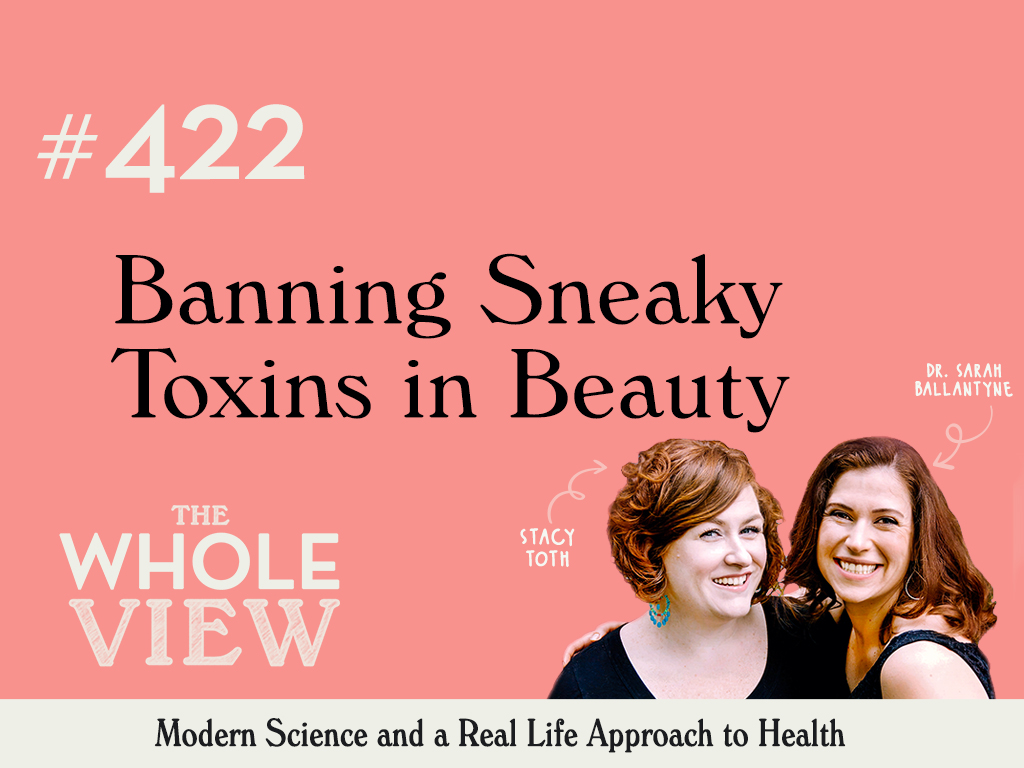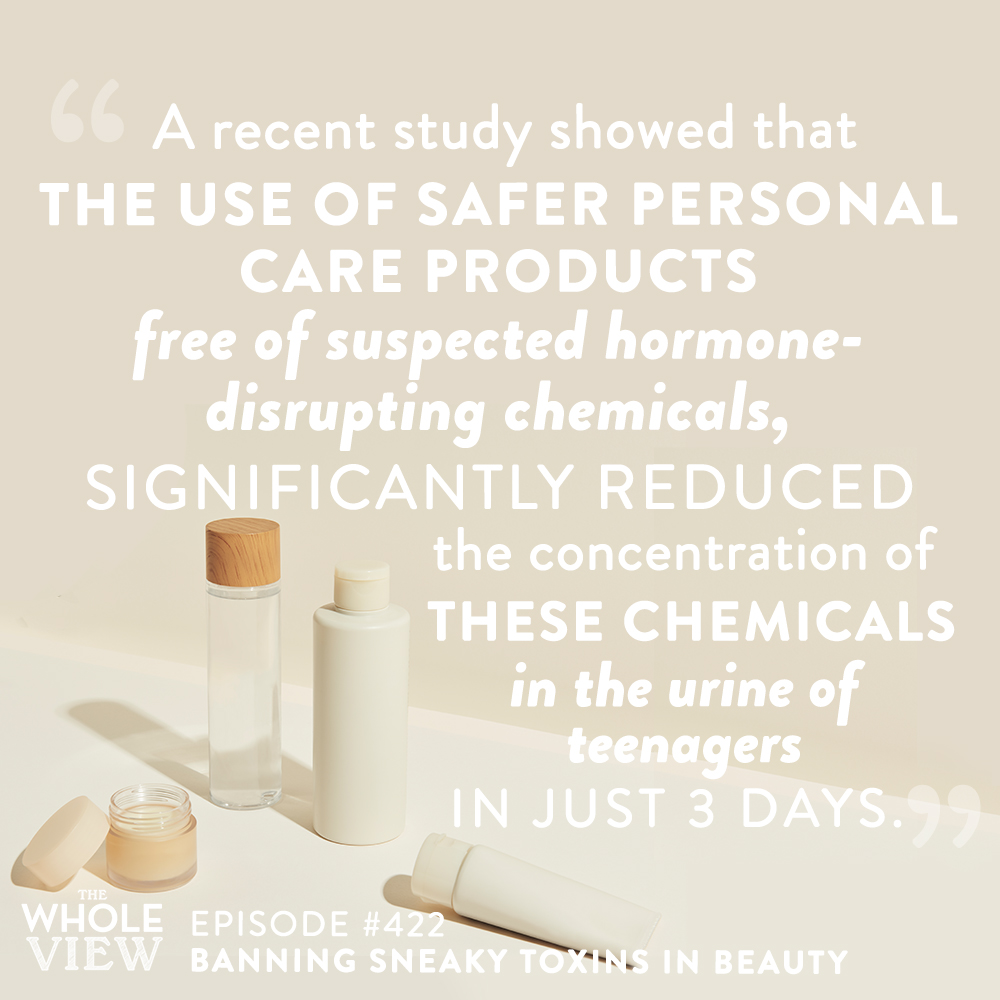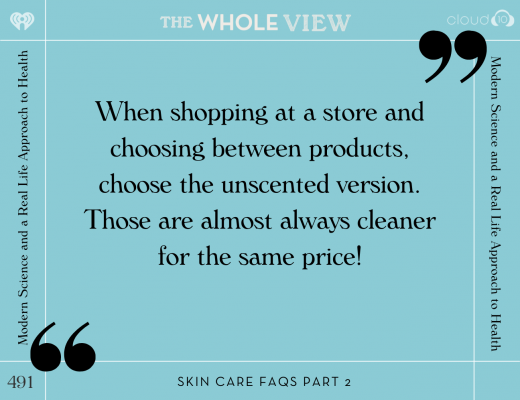
Welcome to episode 422 of The Whole View! This week Stacy and Sarah share some exciting updates on two personal care product bills that were mentioned in previous episodes that have since made progress on capitol hill! Stacy provides more insight into the bills and how they will impact our options as consumers in the US, and Sarah breaks down the science on why certain chemicals will be banned from personal care products in the years ahead. All of this and more in episode 422!
If you enjoy the show, please review it on iTunes!
The Whole View, Episode 422: Banning Sneaky Toxins in Beauty Products
Welcome back to episode 422 of the Whole View, where it is upside down world again and Stacy is leading this week’s show. (0:27)
Stacy has an exciting update on toxins in personal care products and she wants to share some good news.
In everything that is happening in 2020, celebrating good news is very important.
This year, in January or February, Stacy mentioned that there was an actual hearing that moved progress at a federal level.
Then it was sitting in committee, which is what happens when a bill is made.
There are two bills that are passed and are sitting on the governor’s desk in California.
California has a lot going on right now, so they aren’t yet signed and in action.
Sarah took a moment to acknowledge our West coast listeners.
We are thinking about you, we hope you are safe, and we know that this is a lot on top of what has already been a lot.
Know that you are all on all of our minds – please take care.
California, Oregon, and Washington – we are sending all our love.
Sarah talked to Stacy about the satellite images from the fires.
Stacy is personally donating half of her Beautycounter commission in the month of September to support food access for those who have been displaced from the California wildfires. [shop here to choose a fundraiser]
She has such a hard time processing all that is currently going on in the world, and giving her time and money is a way that she is able to positively impact the negative.
Two Bills in California
California represents one-sixth of the United States economy and passing laws there means that businesses have to abide by those rules. (5:28)
Some brands may decide to come up with two formulas.
However, when Stacy says that there are two bills passed and awaiting approval in California, it is a great sign.
It means that we as US consumers of those materials will most likely benefit from them on almost all products.
So while it is a California bill and not a federal bill, these things are incredible for the benefits of everybody.
These bills have been so important to Stacy and her mission.
We didn’t know if and when we would see progress on these, so seeing both of these come up in the last few months has been an incredibly positive lift.
Stacy wants to talk a little bit about both of these bills and what they mean to everybody.
Sarah also has some science to share on this all as well.
If this if your first time tuning in and hearing us talk about toxins in personal care products and you want to learn more about this subject, check out these previous podcast episodes: 290, 331, 339, and 395.
Safer Fragrance Bill
The first bill is the Safer Fragrance Bill, which you can learn more about here. (8:05)
This is the first major step towards closing the fragrance loophole.
You have heard us talk about this loophole here before.
When we think about the fragrance loophole, it is not just the toxic ingredients that can be in there.
It is also the ingredients for people with allergens who are trying to avoid things that could cause them personal harm.
This loop prevents them from knowing what is in it because it is literally all hidden under a category called ‘fragrance’.
In general, a brand can say that something is proprietary and trademarked as part of its formula and put it all under the word ‘fragrance’.
When Stacy is shopping for any sort of product, if the word fragrance is on it – she is out.
Even if a brand says ‘natural’, it still feels suspect since the brand is choosing not to disclose that information.
Currently, international trade secret laws keep these full ingredient lists secret.
The California legislature is requiring companies to report the fragrance ingredients that have been deemed hazardous by federal government laws and prop 65 or could be potential allergens.
You may still see fragrance and not know exactly what is in some of them.
However, the law is requiring that anything that has been deemed hazardous at all in America is disclosed.
Sarah noted that it is easier for brands to make their products both available for retail in California, as well as nationwide.
If it is disclosed on the product label in California it will have to be on their California Safe Cosmetics website.
You as a consumer, if you are picking something up and it says fragrance, you could then go to that website and see what would be disclosed on that product.
The items will have a prop 65 warning on them and then you would go to the website to see what it is in them from a toxin or allergen perspective.
Favorite Safe Brands
Stacy does want to take a moment to mention some brands that they both use that do not include fragrance. (13:33)
They are all scented but from a natural perspective.
The brands that Stacy has come to use and trust are Beautycounter, Primally Pure, Herbivore, and Henry Rose.
Ninty-five percent of what Sarah uses are from two different companies.
Allitura and AnneMarie Skincare are those two brands.
Sarah would call these both sophisticated crunchy.
They are using science-backed ingredients that are known to improve the health of the skin.
The ingredients in these two brands are plant extracts, natural clays, and there is not a single ingredient on either of their labels that is a wonky chemical.
Those are Sarah’s go-to’s that her skin responds to.
Sarah noted that there is a bio-individuality when it comes to what our skin responds to.
There are other companies that are doing great work that are keeping their products super clean.
Sarah noted that there are small companies with very high standards about how they source their ingredients.
Just like with any food you consume, be consistent with reading labels.
Formulas change, so be sure to read the ingredients every time.
You can look up ingredients using EWG.
They have a skin-deep database where you can take a picture and scan the barcode of an item to check its safety.
Beautycounter is doing a pop up in Sephora right now if you want to check them out.
Stacy does call this brand out because they are also leading and paving the way in lots of this legislature.
It was their lobbying efforts that brought a portion of this to fruition.
They are also doing safety testing and putting it out there so that other brands can utilize that testing information.
Stacy wants to see the government doing this level of testing as well.
The good news, bad news, on all of this is that it will take companies time to implement these things and to figure out how to be compliant.
We can expect to see this implemented by January 2022.
Toxic-Free Cosmetic Act
The other law, that Stacy is even more excited about, won’t go into effect until 2025 because it is much more complex. (19:26)
The Toxic-Free Cosmetic Act is the first in the United States since 1938 to ban some additional ingredients.
We are talking about twelve of the worst offenders, frequently found in personal care products.
All of the brands mentioned above, do not have any of these offenders in their products.
It will spur companies to reformulate and remove these harmful products.
This will also bring safer products to the US market.
Stacy will say that a lot of the brands in department stores, already have formulas available for purchase in Europe, without these toxins in them.
There are eleven currently banned under the 1938 law.
The new bill will ban an additional twelve, including: Formaldehyde, Paraformaldehyde, Methylene glycol, Quaternium-15, Mercury, Dibutyl phthalates, Diethylhexyl phthalates, Isobutyl parabens, Isopropyl parabens, m-Phenylenediamine, o-Phenylenediamine, and Per- and polyfluoroalkyl substances (PFAS).
These ingredients are in most personal care and household products, which is why this won’t go into effect for some time.
Our hope is that brands will modify their products for consumers across the US.
However, please be aware that perhaps, companies might sell one formula in California and a different formula to other US states.
We will have to see what happens in a few years.
This is huge news!
Many of you helped to make this a reality.
Stacy mentioned this study that is being done in California.
They are looking for participants, and anyone in California is eligible to participate.
Be sure to look into it!
Racial Disparities
There are racial disparities in personal care products. (24:27)
Stacy mentioned the information in this article and the racial disparities in cancer risks, caused by beauty products.
There are many studies, showing how people of color are being exposed at higher rates to these pollutants and toxins that are in hair care products.
The cosmetic products that are marketed to women of color, such as skin lighteners, dyes and hair relaxers, nail polish, contain some of the most concerning chemicals used in cosmetics.
The twelve biggest offenders mentioned above are in these products and are known hormone disruptors and carcinogens.
It is truly incredible to Stacy that we are in the year 2020, and there are marketing techniques that are marketing products that we know are more toxic and unsafe to women of color.
Yet it still happens.
It is not ok.
Stacy is grateful to have found this study that is looking to quantify what is happening.
We have information that we can point to about the type of ingredients that are in certain products.
And we can look at studies that show higher rates of disease linked to using products with these ingredients.
However, until we know exactly what is in products, and what is in people’s blood to show what is happening, it is hard to actually do this.
Sarah shared her feelings on how very unfair these marketing practices are.
These products have a ‘you don’t look right’ message behind them, which Sarah feels is so fundamentally wrong and terrible.
Sarah feels that the predatory marketing is so problematic, especially when these products are damaging to health.
There are studies that have tried to correlate this information before, but we need to stop marketing products this way.
It is not ok to rely on these toxic chemicals.
People of color are already disproportionately impacted by environmental pollutants, more likely to have led in their tap water, etc.
There is already so much systemic racism and injustice that is impacting these communities.
It is just another layer on top of that and needs to end.
This is just another piece of this systemic racism puzzle that needs to be addressed.
Sarah is happy to see California wrapping this into their prop 65 warnings.
The skeptic in Sarah is worried that these companies are going to go to another ingredient that is also bad, trading one bad for another.
Stacy reminded Sarah that positive is positive and we are focusing on the good.
There was a study that was done on lupus rates and why we see a higher diagnosis rate in minority women.
We can point to a lot of the products that Sarah mentioned as being so much more harmful than a simple product.
It is a snowball effect of how early are you exposed, how much are you exposed, what are the type of products/ingredients you are being exposed to – to quantify the problem.
There is a problem across the board for everybody.
However, we see that it is extreme on this side.
Positive Changes
Stacy mentioned this incredible study that showed how quickly our health can change when we make a switch to safer products. (37:16)
As always, don’t look back at something you have done or have used and feel quilt.
We can only focus on what we can do going forward and be aware.
It is never too late to text ‘betterbeauty’ to 52886 to get your lawmakers to support these when they come up.
There is also something called CEPA Reform that Stacy wants to mention, known as the Canadian Environmental Protection Act.
If you are in Canada, you can actually sign a petition asking parliament to pass policies that strengthen CEPA by banning harmful ingredients, encouraging transparency, and protecting vulnerable populations.
The Worst Offenders – Formaldehyde
Stacy does want to talk about the bad ingredients and why California would choose to ban these. (40:36)
As we look at the worst offenders, it is important to understand what they are and why they are so bad.
We understand that no exposure is a safe amount of exposure for these twelve chemicals.
This is a few different collections of highly related chemicals.
The first four that they are banning are different forms of formaldehyde.
Those four are: Formaldehyde, Paraformaldehyde, Methylene glycol, Quaternium-15.
Formaldeyhde has been known to be a human carcinogen.
On top of that, it is also an irritant to skin, eyes, and lungs.
It can be found in just about any makeup product that has color.
You can also find it in hair straighteners, nail polish, nail treatments, nail hardeners, shampoos, lotions, soap, and deodorants.
There are multiple roots for absorption through the body with these products, which is another reason why it is so problematic.
The Worst Offenders – Mercury
This is crazy that this isn’t banned already, but the heavy metal mercury is also on this list. (44:41)
There is this super awareness of mercury in seafood and why we need to pick seafood with lower mercury levels.
Mercury is a neurotoxin.
Sarah explained the way that mercury is absorbed into the body and the impact it has.
In particular, exposure can damage the kidneys and the lungs can cause kidney failure.
Mercury is in a lot of antiaging products, blemish treatments, and skin lightening products.
This is why it is important to double-check the products you are using.
If you would like help figuring out how to avoid them, Stacy would be happy to help point you to some safer options.
The Worst Offenders – Phthalates
The next chemical is phthalates and is one of the compounds that are in plastics. (48:02)
There is something well understood about this chemical to be an endocrine disruptor.
They can be easily absorbed through the skin and inhalation.
You can also get them through the oral route as well.
There are two phthalates in particular that are being banned in this new law – Dibutyl phthalates and Diethylhexyl phthalates.
These are some of the best understood.
Dibutyl has been shown to be a developmental toxicant, which means it is toxic to a developing fetus.
It has been specifically shown to harm the male reproductive system, and even cause early puberty in boys.
Diethylhexyl also harms the reproductive system and is also a developmental toxicant.
It is also classified as possibly carcinogenic by the International Agency for Research on Cancer.
These phthalates are in a lot of fragranced household products.
Sarah provided examples of these products.
Stacy mentioned a room spray by Primally Pure.
Also, check out this brand of scented trash bags that are free of chemicals.
The Worst Offenders – Parabens
The next chemical class is parabens. (58:13)
Parabens are typically used as preservatives.
They prevent the growth of bacteria or fungi that might cause spoilage of a product.
Parabens are well known to be endocrine disruptors.
There are Isobutyl parabens and Isopropyl parabens.
They have the strongest estrogenic activity among all of the parabens that are widely used in personal care products.
The consequence is that they are estrogen mimics.
So they have pretty strong reproductive toxicity, but they are also strongly associated with estrogen-related cancers.
They are found in shampoos, conditioners, lotions, cleansers, shower washes, and scrubs.
The Worst Offenders – Phenylenediamine
The other ones are m-Phenylenediamine and o-Phenylenediamine, which have fairly strong mutagenic properties. (1:01:22)
They cause mutations in our DNA, which are one of the things that lead to cancer.
When they are mixed with hydrogen peroxide they have mutagenic properties.
This happens all the time since these are common in hair dyes when you are getting your hair lightened.
Stacy mentioned that she use to cough when she was getting her hair colored.
The product would be burning her scalp and then she would be coughing a lot.
Looking back at that, she was ingesting the steam and the air from these chemicals that were mixing together and her body was telling her it wasn’t right.
Sarah noted that there is frequent exposure since people have their color updated as their hair grows.
There are temporary dyes that aren’t as harsh.
Morroco Method is the brand of hair care products that Sarah uses, and they have henna hair dye options to look into.
Also, look for organic salons in your area – they will be able to help with product and treatment options.
The Worst Offenders – PFAS
The last one on the list is polyfluoroalkyl substances, which are also called the forever chemicals (PFAS). (1:1119)
They have been linked to all kinds of problems.
These chemicals are carcinogenic, immunotoxic, causes liver damage, harm to the reproductive system, and harm to developing fetuses as well.
We think of PFAS as being the thing in Teflon.
It turns out non-stick is something that you would also find in a variety of cosmetics.
These products include dental floss, nail polish, eye makeup, and facial moisturizers.
It is called a forever product because it never breaksdown.
We don’t really still know how it builds up in the human body.
This is one of those chemicals that we need to get rid of in everything.
It needs to be not made anymore.
Stacy recommends this dental floss.
Closing Thoughts
Stacy feels like we have covered a lot of ground in this show. (1:36:34)
California is paving the way for hopefully the rest of the country to follow suit eventually.
We hope to see both of these bills become formally and officially signed relatively quickly.
If you are in California, go ahead and shoot him a quick note that you are proud that he is about to sign these into action.
We are excited to see some progress in this area, especially given how far behind the US is compared to Europe and Canada.
Thanks for hanging in!
We will be sharing our real thoughts on this topic over on Patreon, so be sure to stop by there.
If you have follow up questions, comments, suggestions, compliments, we love hearing from you.
You can reach out via social media or via email.
Don’t forget to also sign up for our newsletters.
Thanks for listening – we will be back next week! (1:18:26)





